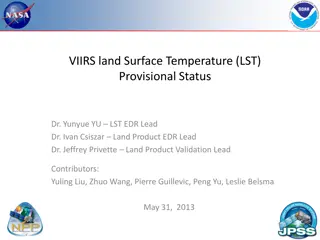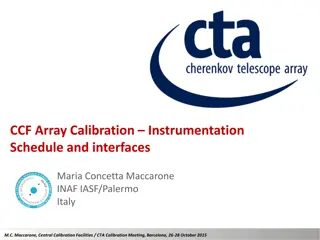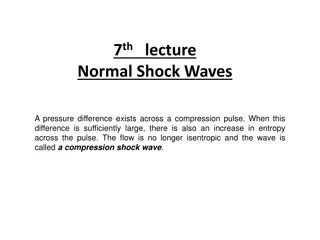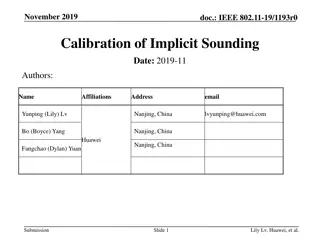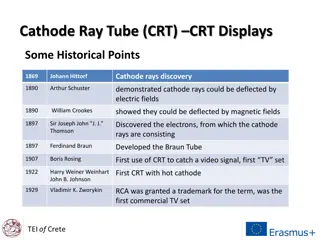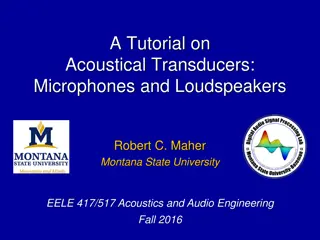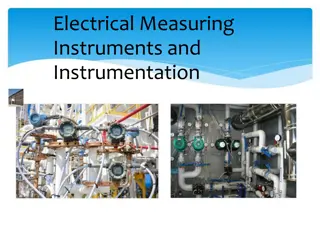Dynamic Calibration of Pressure Transducers in a Shock Tube
This study focuses on the dynamic calibration of pressure transducers in a shock tube to understand boundary layer stability and transition. By creating a shock to impact a Kulite pressure transducer mounted at the end of the tube, researchers aim to determine key parameters such as resonance, damping, and frequency response. The design considerations for the dynamic cell involve factors like shock tube dimensions, diaphragm materials, and structural choices for optimal performance. Overall, the research aims to improve data processing and signal accuracy for better data collection.
Download Presentation

Please find below an Image/Link to download the presentation.
The content on the website is provided AS IS for your information and personal use only. It may not be sold, licensed, or shared on other websites without obtaining consent from the author. Download presentation by click this link. If you encounter any issues during the download, it is possible that the publisher has removed the file from their server.
E N D
Presentation Transcript
Dynamic Calibration of Pressure Transducers in a Shock Tube: Boundary Layer Stability & Transition Laboratory Dashiel Pudwill April 18, 2020
Background/Motivation Pressure Transducers: Second-order Systems Governing equation of the form shown below Source: UofA AME 300 Dynamic Cell: Determine resonance, damping, and frequency response of pressure transducers Ability to calculate/account for how the sensor signal will change in response to step function Allows for better data processing through output filtering Second-order systems response to a step-input=1 with different values of damping ratios
Purpose of Dynamic Cell Create a shock to impact a Kulite (brand of pressure transducer) mounted at the end of a shock tube By mounting the transducer on the end-cap of the shock tube, a clean step function, pressure vs time, is what the Kulite is attempting to measure Output signal of Kulite will be able to determine the rise time, settling time, natural frequency, and overall frequency response of the transducer The diaphragm of the Kulite is the part of the device we wish to characterize Model to be used: XCE-062 Shock Tube replicates shock conditions (scaled) on the Kulites experienced in the full-size tunnels Information about frequency response can be applied to output filtering and the signal conditioners to have cleaner data collection Source: Kulite Source: UofA AME 300
Design Considerations for the Dynamic Cell Ideal design will allow 100 ms time delay between shock impact on transducer and the interference of expansion waves (being reflected back into transducer from wall). Utilize X-t diagrams: illustrate at which point interference from expansion waves occurs. Shock wave needs to have sufficient time to normalize (become perpendicular to tube wall). Shock needs to be able to collapse upon itself to have linearity. Shock tube has an inner diameter of 3.068 inches. Shock must move 20-times the pipe diameter (61.36 inches or 5.11 feet) to fully normalize prior to impacting Kulite. Diaphragm should burst beginning at center to have uniform shock formation/consistent starting of tube Use thin mylar sheets for diaphragm Structural considerations Use of 304/316 stainless steel because of their resistance to corrosion Schedule 40 pipe used to ensure the pipe would be safe at designed pressures with a large factor of safety Nominal pipe size of 3 inches was most cost efficient while attempting to maximize volume for air flow Source: Wikipedia
Approach Generate a normal shock to induce pressure increase across transducer Pressure ratio designed to accurately match conditions experienced in wind tunnel test section (as closely as possible) Can determine pressure and temperature ratios from incident and reflected shock waves
Dynamic Cell Design Kulite mounted in back-wall of the shock-tube (to have as close to perfect of a step function being measured) Total Shock Tube Length: 12 feet (2x 6 feet pipes) Inner Diameter of Shock Tube: 3.068 inches Bolt on flanges to form the ends of the shock tube Weld on flanges on the inner ends of the two pipes Diaphragm portion formed by four individual steel plates Two permanent plates to match inner diameter of the pipe Two removable plates that will hold the mylar in between them, modifiable Dowel pins ensuring alignment between each set of plates Material: Stainless Steel
Parts Received/Raw Materials (2) Six-foot stainless steel pipes (4) Unthreaded stainless steel flanges (2) Stainless steel end caps (2) inch thick stainless steel plate (2) inch thick stainless steel plate Stainless steel bolts Stainless steel dowel pins Source: Des Moines Steel Source: McMaster Carr Source: TorqBolt
Difficulties to Overcome Flanges must be welded to the pipe; very difficult to implement while keeping the parts concentric Thus, the requirement for the two additional permanent plates to ensure there is no step from the driver section to the vacuum section After welding, additional machining is very difficult with such a large assembly (in- house machine shop does not have lathe large enough to accomplish this) The flange may be welded crooked onto the pipe The end of the pipe may have come out of round near the welding region Characterizing of mylar sheets Due to material properties, a given thickness of mylar may burst at a variety of different pressures Multitude of tests must be performed to average the data The thickness of mylar determines the pressure difference before it burst and thus the Mach number of the shock tube
Next Steps Welding of pipe to flanges Machining of permanent and removable plates Design of Kulite mount on end cap of shock tube Design of vacuum and pressure lines into opposing ends of the dynamic cell Construction of a saddle to hold the shock tube Characterization of mylar diaphragms Testing -> recording of frequency response of Kulite Implementation of recorded data through output filtering in real wind-tunnels Source: UofA AME Department





